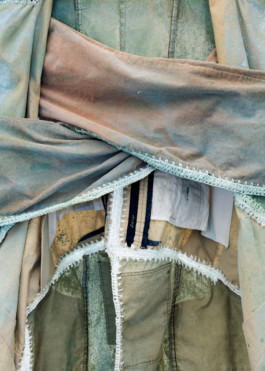









The exhibition by Rafael Kouto presents a complex and evocative exploration of clothing both as a artistic medium and cultural artifact. The displayed garments transcend their utilitarian purpose, becoming sculptural totems imbued with ambiguous symbolism. This transformation is achieved through their presentation on metal frames, which invites us to perceive the fabrics not just as objects to be worn, but as forms that embody new draperies, transparencies, and shapes. Suspended from the ceiling, the clothing animates the space, moving rhythmically as if endowed with their own life force, engaging us in a dialogue of movement and presence.
Oscillating between the public and private space, the image of a stretched out Black body on the window serves as a liminal moment, blurring the boundaries between the interior exhibition space and the external public realm. Through the play of light and shadow, this visual element creates a dynamic re-appropriation of space, inviting contemplation from both inside and outside the installation.
Using second-hand pants as a starting point of the VU.CH residency, Rafael Kouto has produced three jackets that epitomize collaboration and hybridity. The collaborative nature of the project is underscored by contributions from various artists and participants: Griscenda Niggli’s crochet work, Jean-Vincent Simonet produced the images printed on the textiles, Ayomide Tejuoso Plantation photographed performer and artist Elie Autin wearing Kouto’s creations, and the creative input of participants from Les Ateliers de réhabilitation through small paintings to the jackets.
Rafael Kouto’s work poses profound questions about the symbolic extension of the body beyond the physical confines of fabric: “Is there a possible extension of the memory of an absent body, whether dead, desired, or dreamed of, beyond the dimension delimited by the four sides of the fabric rectangle? How can bodies acquire new symbolism?” By wrapping textiles around representations of racialized bodies, printed with their own images, the installation creates a mise en abyme—a reflection within a reflection—that delves into subjects of memory, identity, and the legacy of colonialism.
This layering of imagery and fabric becomes a metaphor for the construction of identity and the complex history of marginalized communities. Kouto’s homage to these communities and his analysis of body physiognomy echo Richard Sennett’s reflections on the symbiotic relationship between body and tool. In the installation, the garments are not mere tools but become extensions of the body, highlighting the interdependence and mutual shaping of identity and material culture. The artist challenges us to reconsider the narrative potential of clothing and the profound ways in which it intersects with memory, identity, and the historical narratives of exploitation and marginalization.
The exhibition has been realized in collaboration with VU.CH | CHUV and Positive Life Festival, an initiative of the Department of Infectious Diseases at the CHUV that aims to counteract ignorance and create new ideas about living with HIV.
In artistic collaboration with Elie Autin, Griscenda Niggli, Jean-Vincent Simonet and Ayomide Tejuoso Plantation.
Text excerpts by Agathe Naito and Rosalie Vasey, curators VU.CH | CHUV.
The exhibition by Rafael Kouto presents a complex and evocative exploration of clothing both as a artistic medium and cultural artifact. The displayed garments transcend their utilitarian purpose, becoming sculptural totems imbued with ambiguous symbolism. This transformation is achieved through their presentation on metal frames, which invites us to perceive the fabrics not just as objects to be worn, but as forms that embody new draperies, transparencies, and shapes. Suspended from the ceiling, the clothing animates the space, moving rhythmically as if endowed with their own life force, engaging us in a dialogue of movement and presence.
Oscillating between the public and private space, the image of a stretched out Black body on the window serves as a liminal moment, blurring the boundaries between the interior exhibition space and the external public realm. Through the play of light and shadow, this visual element creates a dynamic re-appropriation of space, inviting contemplation from both inside and outside the installation.
Using second-hand pants as a starting point of the VU.CH residency, Rafael Kouto has produced three jackets that epitomize collaboration and hybridity. The collaborative nature of the project is underscored by contributions from various artists and participants: Griscenda Niggli’s crochet work, Jean-Vincent Simonet produced the images printed on the textiles, Ayomide Tejuoso Plantation photographed performer and artist Elie Autin wearing Kouto’s creations, and the creative input of participants from Les Ateliers de réhabilitation through small paintings to the jackets.
Rafael Kouto’s work poses profound questions about the symbolic extension of the body beyond the physical confines of fabric: “Is there a possible extension of the memory of an absent body, whether dead, desired, or dreamed of, beyond the dimension delimited by the four sides of the fabric rectangle? How can bodies acquire new symbolism?” By wrapping textiles around representations of racialized bodies, printed with their own images, the installation creates a mise en abyme—a reflection within a reflection—that delves into subjects of memory, identity, and the legacy of colonialism.
This layering of imagery and fabric becomes a metaphor for the construction of identity and the complex history of marginalized communities. Kouto’s homage to these communities and his analysis of body physiognomy echo Richard Sennett’s reflections on the symbiotic relationship between body and tool. In the installation, the garments are not mere tools but become extensions of the body, highlighting the interdependence and mutual shaping of identity and material culture. The artist challenges us to reconsider the narrative potential of clothing and the profound ways in which it intersects with memory, identity, and the historical narratives of exploitation and marginalization.
The exhibition has been realized in collaboration with VU.CH | CHUV and Positive Life Festival, an initiative of the Department of Infectious Diseases at the CHUV that aims to counteract ignorance and create new ideas about living with HIV.
In artistic collaboration with Elie Autin, Griscenda Niggli, Jean-Vincent Simonet and Ayomide Tejuoso Plantation.
Text excerpts by Agathe Naito and Rosalie Vasey, curators VU.CH | CHUV.









